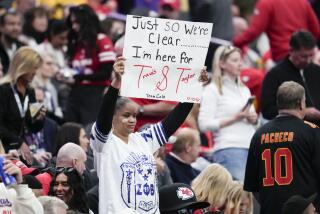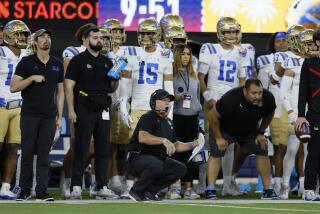Trouble, Either Way : Kelly All Control, Elway All Chaos; Each Is a Winner
They have shared time and space for so long that it’s easy to forget, beyond the obvious, how little Jim Kelly and John Elway have in common as quarterbacks.
Both were drafted in 1983, two whips of cream in a most impressive quarterback crop. Both are 6 feet 3 and about 220 pounds. Both have rifles for throwing arms. Both turned losing franchises into winners, turned heads with their heroics, turned scoreboards into fireworks.
Both quarterbacks have led their teams to Super Bowls and lost. They were born four months apart in 1960; their names begin and end with the same letters, J and Y.
It seems fitting that Kelly and Elway should finally square off in a game of such significance as Sunday’s AFC championship meeting between the Buffalo Bills and Denver Broncos at Rich Stadium.
Elway and Kelly are superstars who arrived at the same place via different roads. Kelly of the Bills took the expressway, driving safely within the lanes of his explosive no-huddle offense.
Elway of the Broncos is a back-roads man, a puddle jumper.
He remains at his best with his team on the brink of cataclysm, when the ball ends up at his two-yard line with two minutes left and his team trailing by a point.
Kelly is about precision, execution, formations. Elway is about bedlam. Kelly is more dangerous when his plays work; Elway is better when his don’t.
It proves only that there is more than one way to carve up defenses in the NFL.
“I would look at Kelly as more of a surgeon,” said longtime Ram defensive coordinator Fritz Shurmur, who now coaches defense for the Phoenix Cardinals.
“He’s a guy who’s going to pick you apart. He’ll throw a lot of things underneath, control you with the pass. Whereas Elway. . .”
Whereas Elway . . . That’s the lament of defensive coordinators across America.
Last week against the Houston Oilers, Elway, for the 19th time in a nine-year career, rallied the Broncos to a fourth-quarter comeback victory.
Never has Elway been better, driving his team 87 yards in 12 plays in two minutes, with no timeouts, to the game-winning field goal against Houston.
Two fourth-down conversions on the march drove the Oilers into the off-season. On fourth and six at his 28, Elway scrambled seven yards for a first down.
“It takes a lot of nerve on his part to have the confidence in his speed to do that,” Denver Coach Dan Reeves said.
Then on fourth and 10 at his 35 with 59 seconds left, Elway somehow eluded the rush of defensive end William Fuller--”I was that close to sacking the dude,” Fuller said--before flipping a short, wobbling pass to Vance Johnson in the left flat. Vance turned it into a 44-yard gain to the Oiler 21.
Both plays were Elway ad-libs after the designed play had broken down. Because Elway ran on the first of those fourth downs, the Oilers had to consider the run on the second. But Elway stopped short the second time and dumped a short pass to Johnson instead.
“He started to move around, the guy came off coverage and he dumped the ball off and it turned out to be the biggest play of the drive,” Shurmur said of Elway. “Not by design.”
Denver receiver Michael Young estimated that Elway deviated from the script on all but the first play of Drive II--a 22-yard pass to Young on first down from the Denver two.
What gets into Elway when a game is on the line?
“It’s so much different than a regular football game,” he said. “You don’t have time to think about what happened on a previous play or what they’re doing. You just get out there and play ball, and you’re going about 100 miles an hour.”
Elway, too, has natural gifts as a runner that Kelly does not possess.
“He’s a much better passer when he’s out of the pocket,” Oiler safety Bo Orlando said.
Kelly never was much of a runner, and years of pounding have made him less so. Before he joined the Bills in 1986, Kelly was sacked 110 times in two seasons with the Houston Gamblers of the United States Football League.
Now looking as large as a linebacker, Kelly stands in the pocket, his legs heavy with knee braces.
“Whereas Elway,” Shurmur continued, “I look at his tremendously strong arm and his ability to move the ball and then scramble to make the play with his own athletic ability. Therein lies the difference between the two, and probably the two systems.”
Elway is the system in Denver, the center of its universe. Assigned plays more often appear loose outlines, subject to change at Elway’s athletic whims.
With lesser talent around him, Elway has pretty much carried the Broncos on his shoulders for nine seasons, a burden he endures through good times and bad.
Elway’s career statistics are not overwhelming. He has thrown for more than 20 touchdowns in a season once--22 in 1985--and has passed for only eight more touchdowns than interceptions, 148-140.
By contrast, much maligned Raider quarterback Jay Schroeder has about the same touchdown to interception ratio, 94-88.
So much for statistics.
With a game on the line, Elway brings to a huddle the unexplainable, “those saucer eyes,” teammate Young calls them.
While Kelly embarrasses you with his skills, Elway’s method has been to lull a team for three quarters and break its heart in the fourth.
In Buffalo’s no-huddle offense, Kelly’s job, more clearly defined, is to spread the ball around to a wealth of offensive talent--Thurman Thomas, Andre Reed, James Lofton.
The strategy has produced an offense for the ages. Kelly threw for a franchise-record 33 touchdowns and 3,844 yards in 1991. And he sat out the last regular-season game.
Kelly is at his best in a controlled-attack offense. He is a pioneer of Mouse Davis’ run-and-shoot, which Kelly ran with brilliance in the USFL. With the Gamblers, Kelly set the professional football record when he threw for 574 yards in a game against the L.A. Express.
When he joined the Bills in 1986, Kelly suffered in the more conservative offense of new Coach Marv Levy. Kelly kept prodding Levy for more freedom and finally, with the help of offensive coordinator Ted Marchibroda, the Bills converted to the no-huddle in 1990 and took off on their Super Bowl run.
Kelly said he prefers the no-huddle offense because, unlike the run-and-shoot, the Buffalo offense includes a tight end for protection.
“It’s a lot more fun,” Kelly said. “I don’t take as much of a pounding as I did in the run-and-shoot in the USFL. Everybody’s used to doing it now and every week we put in different wrinkles to keep one step ahead of the opposing teams.”
It is interesting to consider how Elway might operate in Kelly’s world. Would Elway have the patience to run a precision offense, or would his natural athletic ability and instincts prove a detriment?
Quarterback Steve Young, another great athlete, was criticized in San Francisco this season for being too undisciplined in the controlled-passing game made famous by Joe Montana.
Then again, imagine Elway teamed with the likes of Thomas, Reed and Lofton.
With great quarterbacks, does the offense matter?
Kelly clearly has a better arsenal. At the skill positions, the Bills would not in 100 years swap Thomas for Gaston Green, Reed for Michael Young or Lofton for Vance Johnson.
“He’s got some great weapons,” Elway said. “You look at those receivers he’s got. Lofton’s probably the most amazing guy, the shape that he keeps himself in and the performance he puts in year after year. Thomas, to me, is the best back in football with all the different things he can do. It’s kind of like the perfect situation.”
Kelly, in turn, is comparable to Elway as a leader. Remember, he drove Buffalo steadily downfield in the final minutes of Super Bowl XXV, then watched his team lose when Scott Norwood missed a 47-yard field goal in the final seconds.
“They’re both dangerous,” Shurmur concluded. “But just from the standpoint of outright fear, it’s Elway. You can do everything right against him, except that he has more athletic ability than the last guy available and he makes the play.”
More to Read
Go beyond the scoreboard
Get the latest on L.A.'s teams in the daily Sports Report newsletter.
You may occasionally receive promotional content from the Los Angeles Times.











